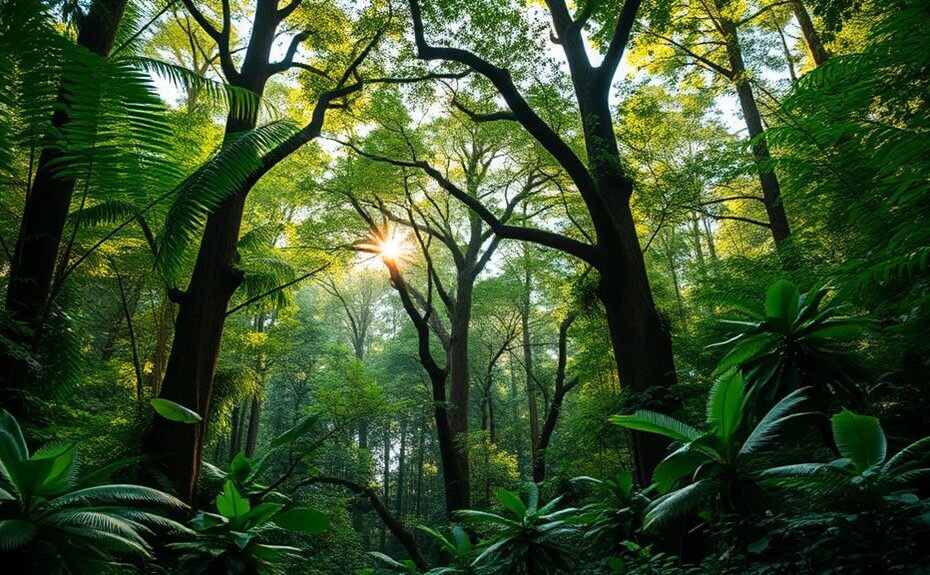The Dipterocarp forests of the Philippines are remarkable giants, reaching heights of up to 100 meters and housing 45 indigenous species. These towering trees provide a vital source of income for the nation, supplying 80% of the country's timber.
Additionally, they support local communities that rely on the forests for their livelihood.
These forests boast rich biodiversity, serving as habitats for unique wildlife. For instance, they are home to endangered species that cannot be found elsewhere. The forests provide a delicate balance of ecological health and human reliance, making them crucial ecosystems.
However, they face significant threats from logging and climate change, which endanger their survival. If these threats are not addressed, the very existence of these ecosystems will be at risk.
Effective conservation strategies are crucial to preserve these ecosystems for future generations. By implementing sustainable forest management practices and protecting these areas from harm, we can ensure the long-term health of the Dipterocarp forests.
Characteristics of Dipterocarps

Dipterocarps are towering hardwood trees that stand between 30 to 50 meters tall. Some species, like Shorea faguetiana, can reach extraordinary heights of up to 100.8 meters. Their straight trunks, typically measuring 25 to 30 meters in length with diameters nearing 2 meters, support the forest canopy, creating a diverse habitat for countless organisms.
The Philippines is home to 45 indigenous dipterocarp species, with nearly half being endemic. This biodiversity enhances ecosystem complexity and stability.
Dipterocarps exhibit irregular flowering patterns, occurring once or twice every decade, significantly influenced by environmental factors like the El Niño-Southern Oscillation (ENSO). Such sporadic flowering affects the availability of seeds, which take around 40 years to produce and roughly 100 years to reach timber size.
The lengthy growth cycle underscores the ecological significance of dipterocarps, as they play a critical role in forest dynamics. Understanding these characteristics not only highlights their biological uniqueness but also emphasizes the vital contribution dipterocarps make to their ecosystems.
Economic Contributions of Dipterocarps
Dipterocarps are a crucial part of the Philippines' forestry industry, providing more than just timber.
Dipterocarps make up 80% of the country's timber resources, making them essential for various sectors. The wood from these dipterocarp species, marketed as Philippine mahogany, is highly sought after for fine furniture, railroad ties, utility poles, and bridges, contributing substantially to both local and national economies.
Dipterocarps also contribute to pulp and paper production and plywood manufacturing, enhancing their value beyond timber alone.
The Apitong species stands out for its non-timber benefits, yielding an oily resin utilized in lamp oil, varnish, and caulking, further diversifying the economic impact of these trees.
However, the increasing demand and exploitation of dipterocarps pose threats to their long-term viability.
Sustainable management practices are crucial to ensure that the economic benefits derived from these forests continue without compromising their ecological integrity.
Biodiversity in Dipterocarp Forests

Dipterocarp Forests: A Treasure Trove of Biodiversity
The economic significance of dipterocarps extends beyond timber, as these forests in the Philippines are home to a rich biodiversity. 45 indigenous dipterocarp species, with nearly half being endemic, showcase a unique biodiversity crucial for ecological balance.
Diverse Ecosystem
Lowland dipterocarp forests can host up to 240 tree species per hectare, primarily from families like Dipterocarpaceae and Euphorbiaceae. This high species density is a testament to the forests' ability to support a wide range of plant life.
Habitat for Endangered Species
These forests provide essential food and shelter for a variety of wildlife, including endangered species like orangutans and the Sumatran rhinoceros. This highlights the vital ecological role of dipterocarp species, ensuring the overall health of tropical forest ecosystems.
Conservation Importance
By protecting these forests, you're not just preserving timber resources but also nurturing a complex web of biodiversity that sustains life.
The conservation of dipterocarp forests is crucial for maintaining ecological balance and supporting endangered species.
Distribution of Dipterocarps
Dipterocarps are predominantly found in the Philippine archipelago, where they're distributed across Palawan, Mindanao, and Luzon. This region is home to 45 indigenous dipterocarp species, with nearly half being endemic. The dipterocarp forests in this region are a critical component of the local biodiversity.
The distribution of dipterocarps isn't uniform due to historical glacial land configurations that isolated populations on single Ice-Age islands. This has led to varying species richness across different areas. For example, the dipterocarp species found in Palawan are different from those found in Mindanao.
The limited seed dispersal capabilities of dipterocarps exacerbate their confined distributions, making them vulnerable to speciation and extinction. This limitation, combined with the destruction of old-growth dipterocarp forests due to logging practices and slash-and-burn agriculture, poses a significant threat to these species.
Logging companies frequently target the last remnants of these ecosystems, severely impacting the distribution of dipterocarps.
As these habitats dwindle, the risk of extinction for several dipterocarp species increases.
Conservation efforts are vital to safeguard these trees and their unique ecosystems, ensuring that the rich biodiversity of the Philippine archipelago can thrive for generations to come.
Threats to Dipterocarp Forests

Dipterocarp Forests Face Multiple Threats
The remaining dipterocarp forests in the Philippines are under threat from various factors. Logging remains the primary concern, driven by economic pressures and the rising demand for timber. This exploitation not only devastates old-growth forests but also endangers approximately 67% of dipterocarp species, with 70 species classified as critically endangered.
Slash-and-burn agriculture further reduces dipterocarp populations and disrupts ecosystems. This practice, combined with logging, has severe consequences for the forests.
Moreover, limited seed dispersal complicates regeneration efforts. Many dipterocarps require up to 40 years to produce seeds and 100 years to reach timber size, making recovery from logging extremely challenging.
Climate change adds another layer of threat, altering growth patterns and increasing the forests' vulnerability to logging and land conversion for agriculture.
Isolated populations hinder genetic diversity, leading to speciation and further decline.
Immediate and effective conservation strategies are crucial to protect what remains of these magnificent giants. Without intervention, the Philippines risks losing not just dipterocarps but the entire ecosystems that depend on them.
Conservation Challenges
Dipterocarp Forest Conservation Challenges
Conservation efforts for dipterocarp forests in the Philippines face significant obstacles due to ecological, economic, and social factors.
Logging and slash-and-burn agriculture have led to the near extinction of old-growth forests. Many species, once common, are now classified as endangered.
The slow reproductive rate of dipterocarps, which takes 40 years to produce seeds and up to 100 years to reach timber size, makes regeneration efforts incredibly challenging.
Logging companies target the last remaining dipterocarp forests in Palawan, Mindanao, and Luzon, resulting in accelerated habitat loss and fragmentation.
Limited seed dispersal further complicates the situation, leading to overcrowding and competition among existing species, which hinders the establishment of new individuals in degraded areas.
Economic pressures and rampant illegal logging activities create additional barriers to effective conservation efforts.
Immediate action and collaboration among stakeholders are urgently needed for sustainable management practices. Without this, the future of these vital ecosystems remains bleak, and the rich biodiversity they support is at grave risk.
Importance of Lowland Dipterocarp Forests
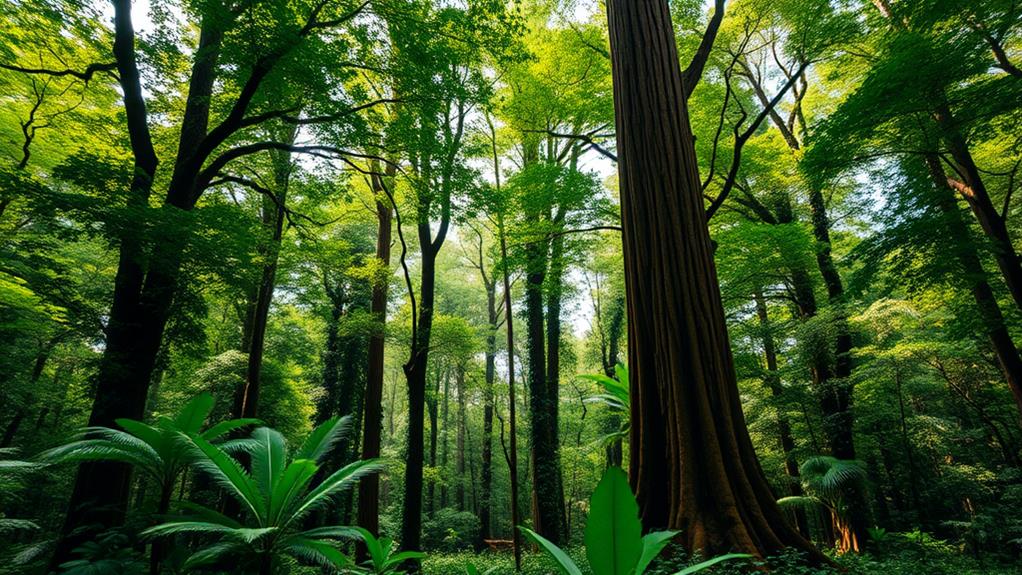
Lowland dipterocarp forests in the Philippines are crucial for maintaining ecological balance and supporting biodiversity. These forests are characterized by high species density, hosting up to 240 tree species per hectare, predominantly from the Dipterocarpaceae family. This diversity is vital for the survival of endangered species, such as orangutans and Sumatran rhinoceroses, as well as numerous other flora and fauna.
Dipterocarps play a significant role in carbon sequestration. They absorb substantial amounts of CO2, thereby mitigating climate change. This ecological function is essential for sustainable environmental practices.
Eighty percent of the Philippines' timber supply comes from dipterocarps, including sought-after varieties like Philippine mahogany.
The unique ecological functions of lowland dipterocarp forests are critical for maintaining tropical forest ecosystems. These functions include soil stabilization and nutrient cycling.
Conservation of these forests is urgent due to their multifaceted contributions to both the environment and local economies.
Wildlife Habitat in Dipterocarp Ecosystems
Dipterocarp ecosystems in the Philippines provide vital wildlife habitats. These ecosystems support a diverse range of species that depend on them for survival. The dipterocarp trees, with their dense canopy, offer essential refuge and nesting sites for various avian species. For example, the endangered Philippine eagle and the threatened white-bellied woodpecker rely heavily on these trees for food and protection.
Larger mammals thrive in dipterocarp forests, showcasing the ecological richness of these habitats. The Philippine tarsier and the Visayan warty pig are two examples of larger mammals that benefit from these biodiverse forests.
Additionally, the forests support a diverse array of smaller mammals, such as the Bornean black-banded squirrel, which plays a crucial role in seed dispersal and forest regeneration.
Dipterocarp forests also host numerous reptiles and amphibians, contributing to the intricate food web and ecological interactions. These ecosystems are critical not only for the species that inhabit them but also for maintaining the ecological balance in the Philippines.
Preserving dipterocarp forests is essential for the survival of these remarkable forest giants and their inhabitants.
Notable Dipterocarp Species
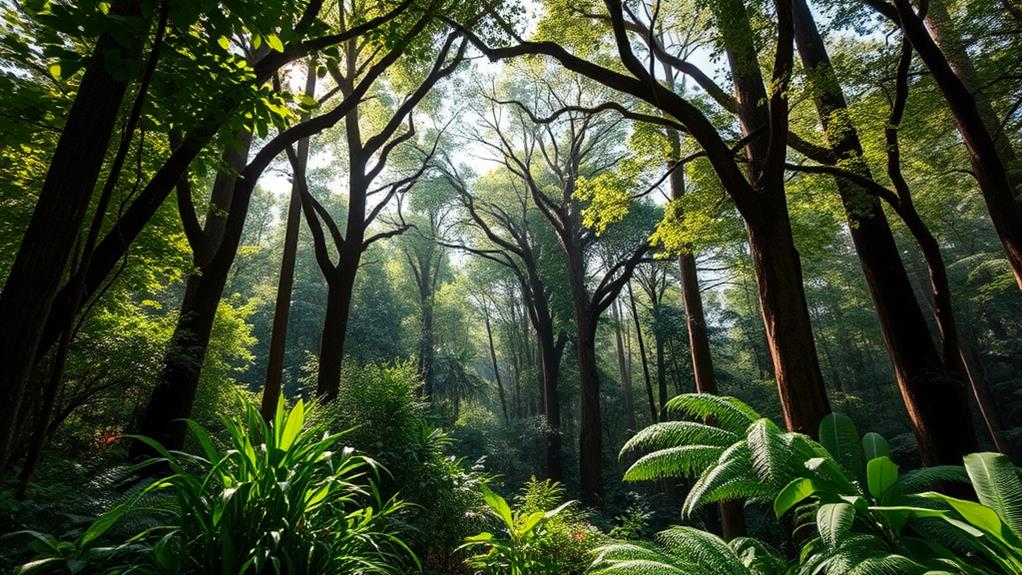
The Philippines is home to a remarkable diversity of dipterocarp species, with 45 indigenous species, nearly half of which are endemic. This uniqueness highlights the importance of conservation efforts.
Several notable dipterocarp species face severe threats. Dipterocarpus littoralis is critically endangered and found solely on Nusakambangan Island.
Dipterocarpus cinereus was rediscovered in 2012, with only 30 mature trees remaining.
Hopea bancana has only nine mature individuals recorded on Mursala Island, indicating a dire population decline.
The Pelahlar tree, known for its branchless trunk, is increasingly threatened by logging activities.
The decline of these dipterocarp species not only diminishes biodiversity but also disrupts the ecosystem services they provide.
Conservation efforts must prioritize protecting these iconic dipterocarp species to ensure the health of the forest.
Addressing logging threats and habitat degradation is essential for their survival and the ecological balance of the Philippines' rich forests.
Global Conservation Initiatives
Dipterocarp Forests: A Global Conservation Priority
Dipterocarp forests are a vital component of global biodiversity, but 67% of dipterocarp species are threatened, making immediate conservation efforts crucial. To address this, organizations like Fauna & Flora International collaborate with local communities to promote sustainable forest management, ensuring these habitats thrive.
Conservation Initiatives
Protected Areas: These safeguard habitats, providing refuge for species. For instance, national parks and wildlife reserves serve as safe havens for dipterocarp species.
Seed Propagation: This restores genetic diversity in degraded areas. By propagating seeds from healthy trees, conservationists can rejuvenate degraded forests and ensure ecosystem sustainability.
Legal Frameworks: These combat illegal logging and land conversion. Strengthening laws and regulations helps prevent the destruction of dipterocarp forests and promotes sustainable land use.
International Cooperation
International cooperation is vital for the conservation of dipterocarp forests. Projects across Southeast Asia aim to restore habitats and protect biodiversity.
By working together, we can foster long-term preservation of these forests.
The Urgent Need for Action
The future of dipterocarp forests and the species they support hinges on our collective response.
We must commit to action to conserve these forests and their inhabitants. Together, we can make a significant difference in preserving these vital ecosystems.
Symbolic Significance of Dipterocarps
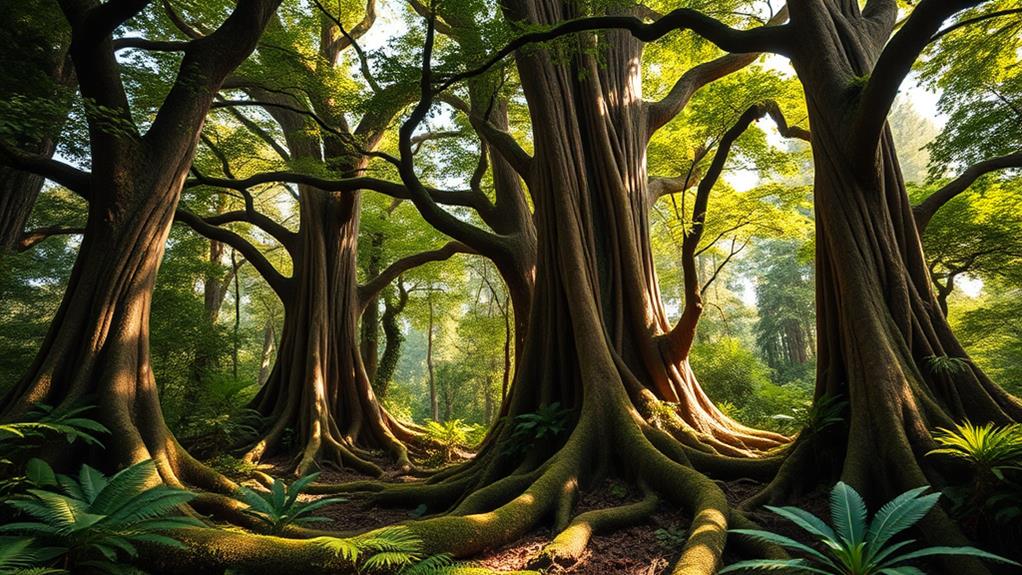
Dipterocarps: The Pillars of Philippine Forests
Dipterocarps are more than just trees; they symbolize the intricate bond between nature and human existence. As keystone species, they maintain biodiversity and provide essential habitats for various wildlife. Their decline signals a broader environmental crisis, impacting other species that rely on these giants for survival.
The Forest Ecosystem
Dipterocarps tower above the forest canopy, offering shelter to countless birds and insects. The rich, diverse undergrowth teems with life, relying on the dipterocarps' shade and nutrients.
Endemic species, unique to the Philippines, flourish in the presence of these majestic trees.
Local Communities and Dipterocarps
Local communities depend on dipterocarps for livelihoods, navigating the tension between conservation and economic exploitation.
The fate of dipterocarps directly affects the well-being of these communities.
The Urgent Need for Conservation
With nearly 45 indigenous species, many critically endangered, the plight of dipterocarps highlights the urgent need for conservation efforts.
The critical status of species like Dipterocarpus littoralis and Hopea bancana serves as a poignant reminder of what's at stake. Protecting these forest giants isn't just about preserving trees; it's about safeguarding an entire ecosystem intertwined with human life.
Impacts of Climate Change
Dipterocarp forests, crucial to the Philippine ecosystem and local communities, face an uncertain future due to climate change. Climate change intensifies existing challenges, disrupting growth patterns and critical flowering and seed production cycles. This irregularity jeopardizes regeneration, essential for sustaining dipterocarp populations.
Rising temperatures and altered precipitation patterns threaten seed germination rates. For example, species that thrive under specific environmental conditions, such as _Shorea contorta_, are particularly vulnerable.
Increased sea levels and intensified storms pose additional risks to lowland dipterocarp forests, especially in coastal areas housing many endemic species like _Hopea philippinensis_.
Climate change may shift the distribution of dipterocarps, leading to potential habitat loss. Some species may be unable to migrate or adapt quickly enough to changing climatic zones.
This stress makes dipterocarp forests more vulnerable to diseases and pests, endangering these vital ecosystems that support high biodiversity and contribute significantly to local economies.
Addressing these impacts is crucial to conserve dipterocarp forests and their benefits.
Sustainable Practices for Conservation
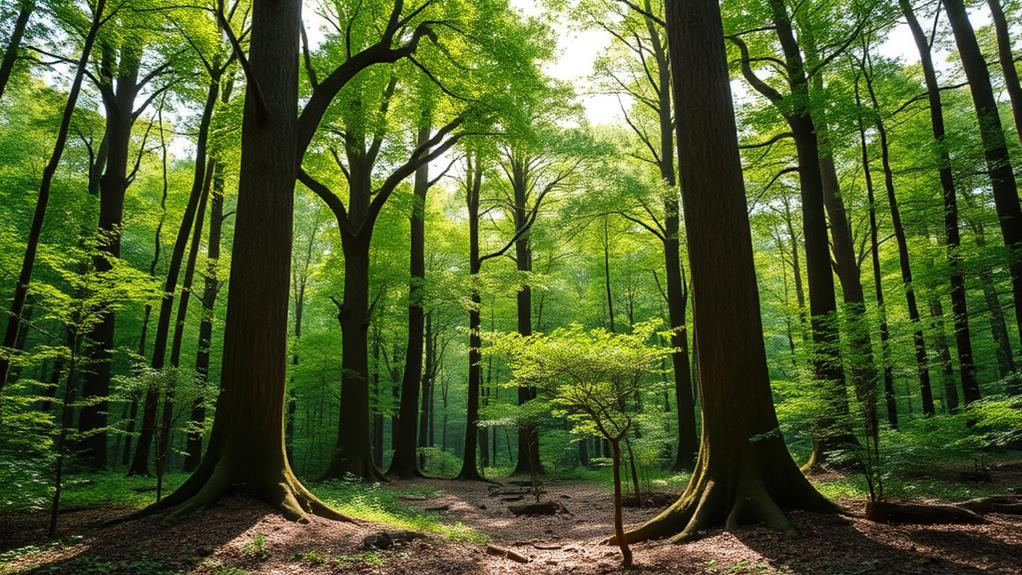
Sustainable practices are crucial for preserving dipterocarp forests and their ecosystems. These methods ensure responsible resource use and contribute to the conservation of these unique environments.
Selective logging allows for timber extraction while maintaining biodiversity. This approach prioritizes the protection of native species and minimizes habitat disruption.
Community-based forest management initiatives empower locals and promote their livelihoods. By involving local communities in decision-making processes, these initiatives foster a sense of ownership and responsibility for forest conservation.
Reforestation projects focusing on native dipterocarp species restore degraded habitats. These efforts help to replenish lost biodiversity and recreate natural habitats for native species.
Strict legal frameworks and enforcement against illegal logging protect remaining forests. Effective laws and regulations prevent further deforestation and habitat destruction.
Education and awareness campaigns targeting stakeholders promote sustainable practices. By educating local communities and industries about the importance of conservation, these campaigns encourage responsible forest management.
Combining these strategies creates a holistic approach to conservation. This integrated approach addresses both ecological health and socio-economic development, ensuring the long-term preservation of dipterocarp forests.
Questions and Answers
What Is the Dipterocarp Forest in the Philippines?
The dipterocarp forest in the Philippines is a biodiversity hotspot, which means it's home to a vast array of plant and animal species found nowhere else on the planet.
These forests are dominated by towering dipterocarp trees that can reach heights of up to 60 meters, providing a habitat for various wildlife and plant species.
The dipterocarp forest contributes significantly to the country's timber resources, with many of the trees being harvested for their valuable wood.
These forests play a crucial role in carbon sequestration, which means they help remove carbon dioxide from the atmosphere, slowing down climate change. The trees absorb carbon dioxide during photosynthesis, storing it in their trunks, branches, and roots.
However, the ecological importance of these forests is threatened by logging and agriculture, which can lead to deforestation and habitat destruction.
To preserve this unique ecosystem, sustainable management practices are urgently needed. This can be achieved by implementing responsible forestry practices, such as selective logging and reforestation, and promoting eco-friendly agriculture practices that don't contribute to deforestation.
What Is the Largest Dipterocarp in the World?
The largest species of dipterocarp is Shorea faguetiana, which can grow to heights exceeding 100 meters. This towering tree is primarily found in the dense rainforests of Sabah, Malaysia, where it thrives in well-drained, fertile soils.
Its impressive structure plays a crucial role in maintaining ecological balance by contributing to the diversity of ecosystems. For example, its growth patterns provide valuable insights into rainforest dynamics, allowing us to better understand the complex relationships within these ecosystems.
What Defines a Dipterocarp Forest?
A dipterocarp forest is defined by its high density of tree species, particularly the Dipterocarpaceae family, which accounts for 40% to 70% of the total tree species. This ecological significance makes them biodiversity hotspots, providing essential habitats for endangered wildlife such as orangutans, elephants, and tigers.
Dipterocarp forests play a crucial role in climate resilience by absorbing and storing carbon dioxide from the atmosphere.
In addition to their ecological importance, dipterocarp forests have economic value, including timber and non-timber products like resin, fruit, and medicinal plants. They also hold cultural significance, being rooted in local traditions and providing spiritual and recreational spaces for indigenous communities.
To preserve these forests, effective conservation strategies are vital, ensuring they continue to support ecosystems and communities alike.
How Tall Are Dipterocarps?
Dipterocarps can reach heights of 35 to 60 meters as mature trees. Some species, like Shorea faguetiana, can grow even taller, up to 100.8 meters. Their towering stature contributes to forest structure and biodiversity.
Dipterocarps take around 100 years to reach 30 meters, which is a slow growth rate. This makes them vulnerable, especially in logged forests where they struggle to regain their former heights.
